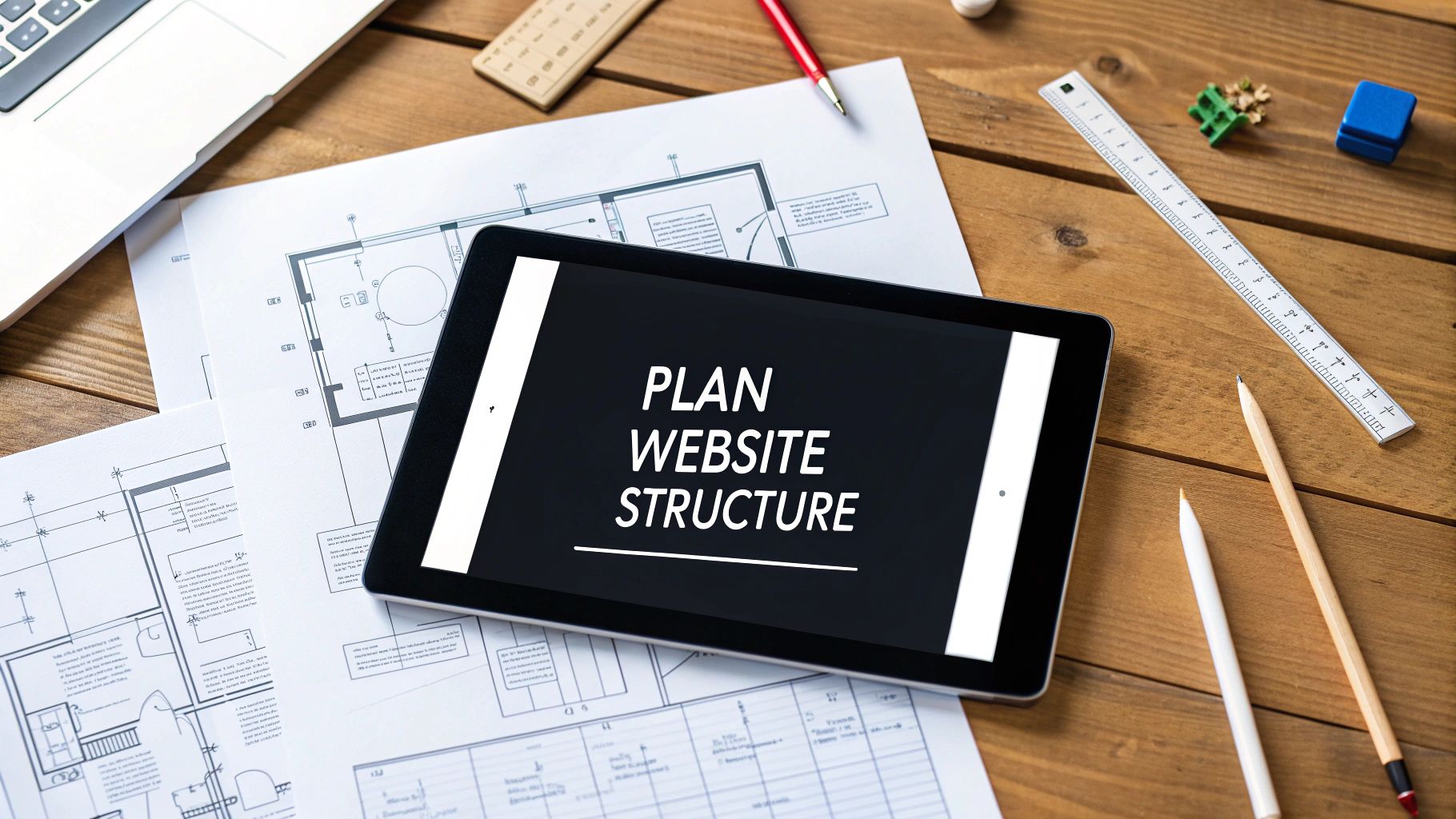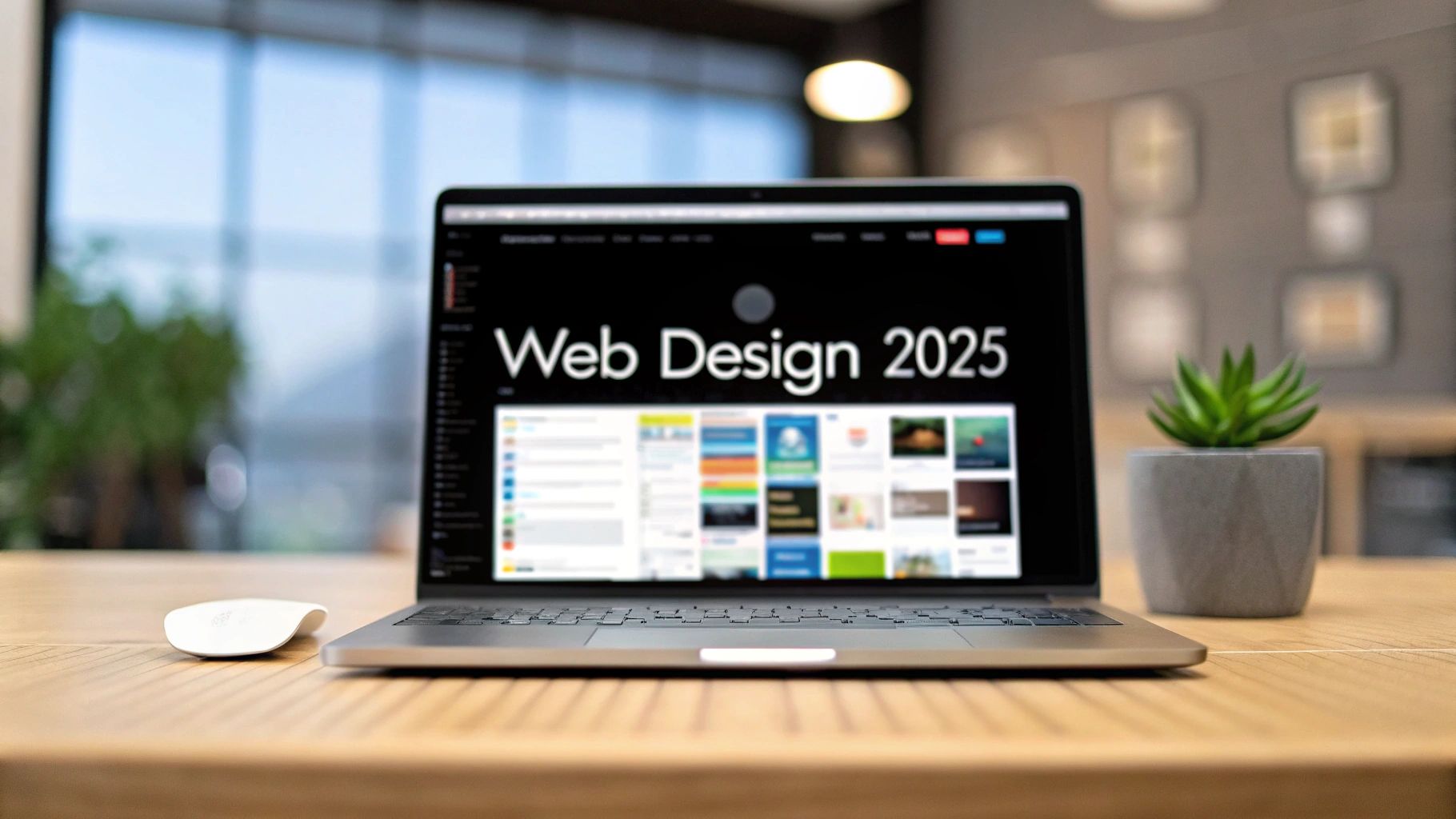
7 Essential Design Brief Example Types for 2025
0
5
0
Every groundbreaking design, from a revolutionary app to an iconic logo, begins not with a sketch, but with a single, crucial document: the design brief. This is the strategic compass that guides creative energy, prevents costly misunderstandings, and aligns everyone on a shared vision of success. Without it, projects drift aimlessly, budgets inflate, and brilliant ideas get lost in translation.
Crafting an effective brief is an art in itself. Too vague, and you invite chaos; too rigid, and you stifle the very innovation you seek to inspire. The goal is clarity, not constraint. This guide is built to provide that clarity. We will demystify the process by dissecting seven distinct types of briefs, covering everything from brand identity to user experience.
For each category, we will analyse a detailed design brief example, highlighting the strategic thinking that sets it apart. You’ll find specific, actionable takeaways and downloadable templates to help you replicate this success. Prepare to move beyond guesswork and transform your creative collaborations into well-orchestrated masterpieces, starting with the perfect brief. Let's explore these examples.
1. Product Design Brief
A Product Design Brief is a cornerstone document that guides the entire lifecycle of creating a new physical or digital product. It acts as a single source of truth for the entire team, from designers and engineers to marketers and stakeholders. The brief clearly defines the product’s purpose, target audience, business goals, and technical constraints, ensuring everyone is aligned and working towards the same vision. This detailed document prevents scope creep and keeps the project focused on solving a specific user problem.
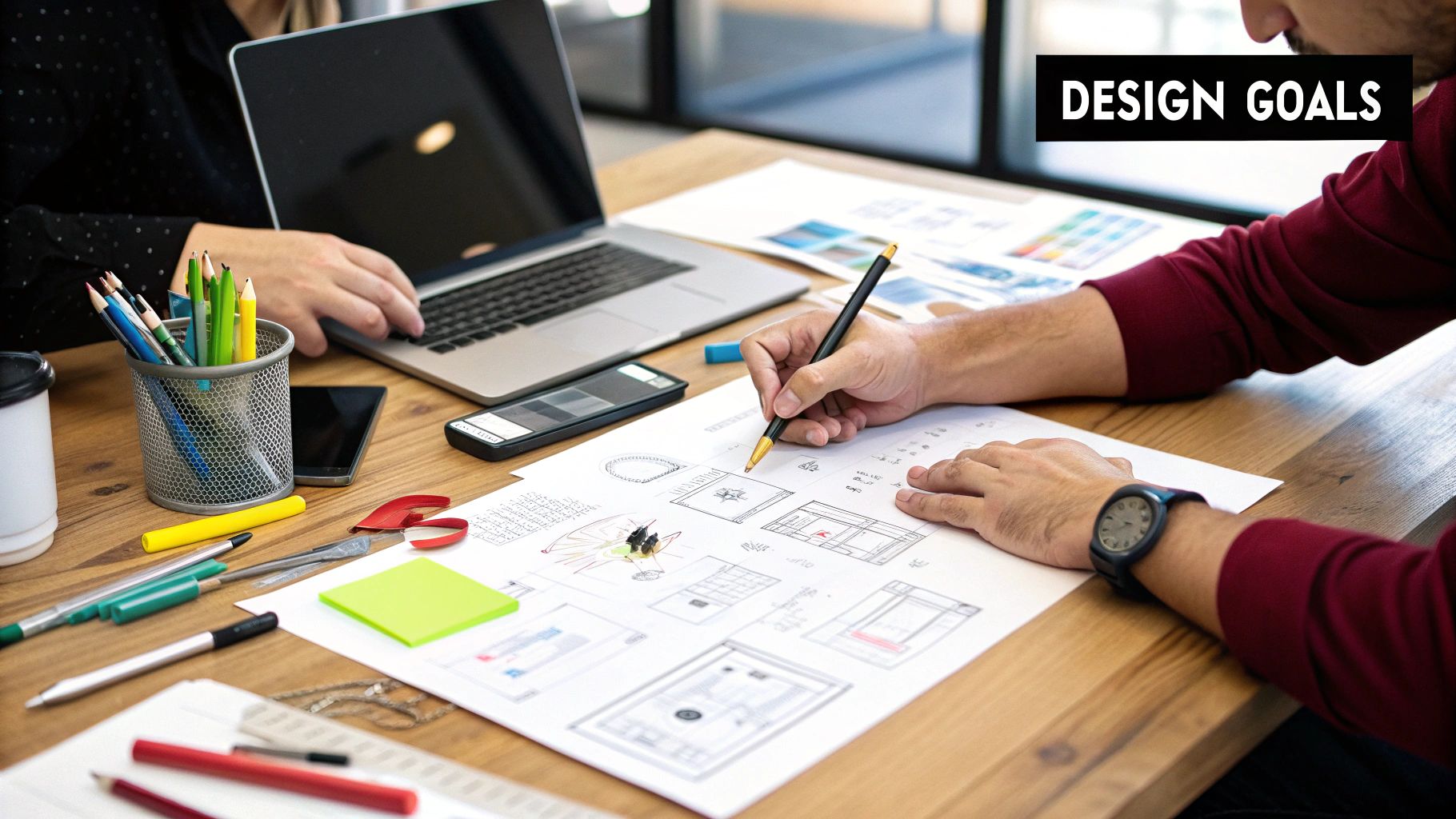
This type of brief is essential for complex projects where multiple teams need to collaborate. Think of the original iPhone development brief, which reportedly prioritised a seamless user experience and revolutionary interface over cramming in features. Similarly, Dyson's brief for its first vacuum cleaner was laser-focused on solving the problem of suction loss, leading to its groundbreaking bagless technology.
Strategic Breakdown
A strong product design brief example will meticulously detail not just what to build, but why. It translates market research and user needs into a concrete plan.
Problem Statement: It begins with a clear articulation of the user problem or market gap the product will address.
User Personas: It includes detailed profiles of the target users, outlining their goals, pain points, and behaviours.
Business Objectives: This section links the product to tangible business outcomes, such as increasing market share or generating a new revenue stream.
Success Metrics: Defines what success looks like with specific, measurable KPIs (Key Performance Indicators) like user adoption rates or customer satisfaction scores.
Actionable Takeaways
To create an effective product design brief, focus on clarity and collaboration.
Start with the 'Why': Before defining solutions, deeply analyse and document the core problem you are solving for your user.
Prioritise Features: Use a ‘must-have’, ‘should-have’, ‘could-have’ framework to differentiate essential features from nice-to-haves. This helps manage scope and resources effectively.
Involve All Stakeholders: Co-create the brief with representatives from design, engineering, and marketing to ensure buy-in and a holistic perspective from the start.
Ready to build a product that truly resonates with your audience? Download our customisable Product Design Brief Template to get started today!
2. Brand Identity Design Brief
A Brand Identity Design Brief is a foundational document that outlines the mission, vision, and core essence of a business. It serves as the strategic blueprint for creating or refreshing a company's visual identity, including its logo, colour palette, typography, and overall brand aesthetic. This brief ensures that the creative team understands the brand’s personality, values, and market positioning, enabling them to develop a visual language that connects with the target audience and stands out from the competition.
This type of brief is crucial for establishing a consistent and memorable brand presence. Consider Airbnb's 2014 rebrand; its brief focused on the concept of "belonging," leading to the creation of the iconic 'Bélo' symbol. Similarly, Mastercard's evolution brief prioritised digital-first simplification to maintain relevance in an increasingly cashless world. This design brief example is vital for translating abstract brand values into tangible visual assets.
Strategic Breakdown
An effective brand identity design brief example goes beyond aesthetics, linking visual choices to strategic business goals. It captures the soul of the brand to guide every creative decision.
Brand Essence & Personality: It distils the brand down to its core idea and uses adjectives to define its personality (e.g., 'playful', 'authoritative', 'minimalist').
Target Audience Profile: It details the ideal customer, including their demographics, values, and motivations, ensuring the identity resonates with them.
Competitive Landscape: This section analyses key competitors, identifying their visual strengths and weaknesses to carve out a unique space in the market.
Mandatories & Restrictions: Clearly defines what the brand is and, just as importantly, what it is not, providing clear boundaries for designers.
Actionable Takeaways
To develop a powerful brand identity brief, you must blend strategic insight with creative direction. A well-crafted brand identity is fundamental to your business's market positioning and directly impacts its success. Explore proven strategies to attract clients and see how a strong brand can fuel growth.
Conduct a Brand Audit: Before you write a single word, thoroughly analyse your current brand identity. Identify what’s working, what isn’t, and what brand equity you need to preserve.
Define Your Brand's Personality: Use a list of adjectives to articulate the desired feel of the brand. Is it innovative and bold, or traditional and trustworthy? This guides all visual choices.
Provide Visual Inspiration: Include a mood board or examples of brands you admire (and those you don't). Crucially, explain why these examples are relevant to your goals to provide clear context.
Ready to define a brand identity that truly captures your business's spirit? Download our comprehensive Brand Identity Design Brief Template to build a memorable brand!
3. Website Design Brief
A Website Design Brief is a critical document that outlines the vision and requirements for creating or redesigning a website. It serves as a comprehensive roadmap for designers, developers, and content strategists, ensuring the final digital product aligns perfectly with business objectives and user needs. This brief details everything from site structure and key user journeys to specific functionalities, technical specifications, and content requirements, preventing misunderstandings and keeping the project on track.
This type of design brief example is fundamental for any web project, whether it's a simple brochure site or a complex e-commerce platform. Consider the famous Gov.uk redesign, where the brief prioritised simplicity and accessibility, resulting in a user-centric site that set a new standard for government websites. Similarly, Stripe’s developer-focused website brief emphasised clarity and comprehensive documentation, establishing it as an industry benchmark.
The process flow below outlines the foundational stages of a website design brief, moving from understanding the audience to defining the site's architecture and required features.
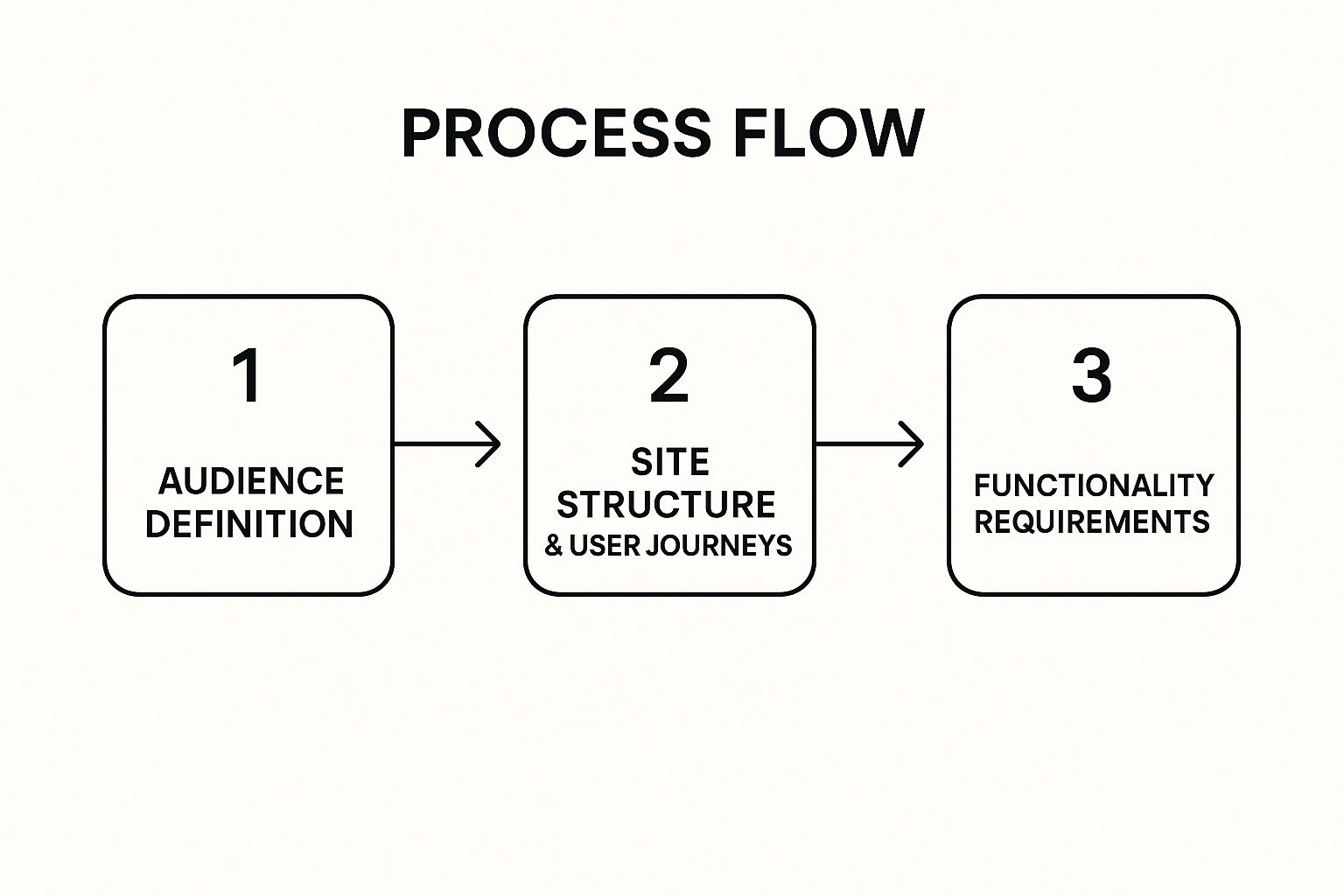
Following this logical sequence ensures that every decision, from layout to technology, is grounded in user needs and strategic goals.
Strategic Breakdown
An effective website design brief translates business goals into a tangible digital experience. It moves beyond aesthetics to define how the site will function and serve its audience.
Audience & Goals: Clearly define the target audience personas and the primary conversion goals (e.g., lead generation, online sales, content engagement).
Sitemap & User Flows: Outline the proposed site structure and map out critical user journeys, such as the checkout process or a contact form submission.
Content & Functionality: Detail content requirements, including any need for a content management system (CMS), and list all necessary functionalities like search, forms, or integrations.
Technical & Accessibility: Specify technical constraints, hosting environment, and, crucially, accessibility standards. To ensure your brief covers all critical aspects of user experience, delve into these 10 essential website accessibility best practices.
Actionable Takeaways
To craft a website design brief that leads to a successful outcome, focus on precision and foresight.
Define Conversion Points: Be explicit about what you want users to do on each page. Clearly define calls-to-action (CTAs) and the metrics you will use to measure success.
Map Key User Journeys: Before any design work begins, visually map out the steps a user will take to complete important tasks. This identifies potential friction points early on.
Prioritise Mobile-First: If analytics show a significant mobile audience, insist on a mobile-first design approach, ensuring the experience is optimised for smaller screens from the outset.
Looking to create a high-performing website for your business? Download our Website Design Brief Template to build your digital foundation!
4. UX/UI Design Brief
A UX/UI Design Brief is a user-centred document that specifically guides the creation and refinement of digital interfaces. It acts as the blueprint for designers, focusing on user behaviour, interaction patterns, and visual aesthetics to ensure a digital product is not only functional but also intuitive and enjoyable to use. The brief translates user research and usability goals into a clear set of requirements for the design team, preventing subjective decisions and aligning everyone on a user-first approach.
This type of brief is critical for projects like app development, software platforms, and complex websites where user satisfaction directly impacts success. Consider Duolingo's brief, which would have prioritised gamification and engagement loops to drive user retention. Similarly, a brief for the Headspace meditation app would have heavily emphasised creating a calm, simple, and intuitive interface to support its core purpose of mindfulness.
Strategic Breakdown
An effective UX/UI design brief example goes beyond visual style, focusing on the why behind every design choice. It is built upon a deep understanding of the user and their journey.
User Research & Pain Points: It starts with findings from user research, including quotes, data, and a clear summary of the problems users face with existing solutions.
User Scenarios & Flows: This details specific tasks the user will perform, mapping out ideal user journeys from start to finish.
Usability & Accessibility Goals: It defines measurable targets for usability (e.g., task completion time) and outlines specific accessibility standards (e.g., WCAG compliance) that must be met.
Interface Requirements: This section specifies technical and visual constraints, including target devices, responsive design needs, and any existing design systems or brand guidelines to follow.
Actionable Takeaways
To craft a powerful UX/UI design brief, ground every requirement in user evidence and clear objectives.
Lead with Empathy: Start by embedding real user quotes and data directly into the brief. This keeps the user's voice at the forefront of every design decision.
Define Interaction Details: Specify expectations for prototype fidelity (low-fi wireframes vs. high-fi interactive mockups) to ensure the design process is efficient and meets stakeholder needs.
Plan for Every User: Integrate accessibility requirements from day one, not as an afterthought. This ensures the final product is usable by the widest possible audience and aligns with modern user experience design best practices.
Ready to design an interface your users will love? Download our detailed UX/UI Design Brief Template to build a better user experience!
5. Packaging Design Brief
A Packaging Design Brief is a critical document for creating product packaging that captivates consumers and functions flawlessly. It serves as a detailed guide that balances aesthetic appeal, brand communication, functionality, and manufacturing constraints. The brief outlines everything from visual design elements to practical considerations like materials, printing processes, structural integrity, and regulatory compliance, ensuring the final product stands out on a crowded shelf.
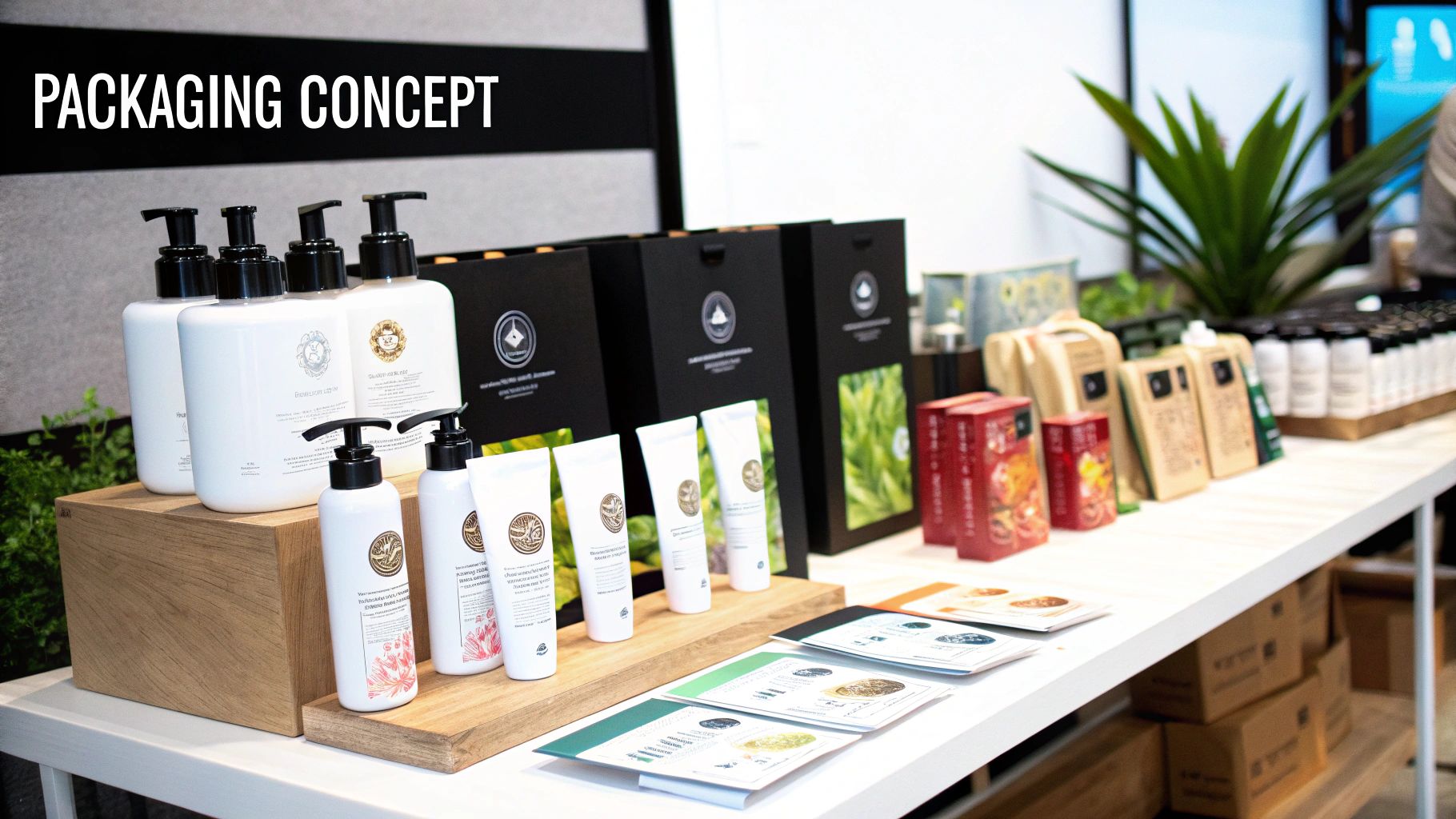
This type of brief is essential for any retail product where the packaging is the first point of contact with the customer. Consider Oatly's distinctive, text-heavy packaging that builds a quirky brand personality, or Glossier’s iconic pink bubble wrap pouches that turned unboxing into a shareable social media moment. These successes were born from briefs that prioritised not just protection, but also brand storytelling and user experience.
Strategic Breakdown
An effective packaging design brief example goes beyond colours and logos to detail the entire user journey. It translates brand strategy and market realities into a tangible manufacturing plan.
Brand & Market Context: It clearly defines the brand’s personality, target audience, and key competitors. How will this packaging differentiate the product on the shelf?
Structural & Material Requirements: This outlines the physical aspects, including dielines, required materials (e.g., recycled cardboard, glass), and sustainability goals. It also specifies primary, secondary, and tertiary packaging needs.
Content & Legal Mandates: It lists all necessary information, such as the product name, weight, barcodes, ingredients, and any legally required warnings or symbols.
Production & Budget: This section details the budget constraints, desired printing techniques (e.g., offset, digital), and the number of units to be produced.
Actionable Takeaways
To develop a powerful packaging design brief, focus on the details and the bigger picture simultaneously.
Consider the Full Lifecycle: Map the customer’s entire interaction with the package, from seeing it on a shelf or screen to opening it, using the product, and finally disposing of the packaging.
Define Technical Specs Early: Include dieline specifications, material preferences, and printing requirements from the start. This prevents costly redesigns and production issues later.
Prioritise Sustainability: Clearly state your environmental goals. Whether it's using recycled materials, reducing waste, or ensuring recyclability, these goals will heavily influence design decisions.
Ready to create packaging that flies off the shelves? Download our detailed Packaging Design Brief Template to guide your next project!
6. Marketing Campaign Design Brief
A Marketing Campaign Design Brief is a strategic document that aligns marketing objectives with creative execution. It serves as the master plan for a campaign, guiding creative teams on how to communicate a core message across various channels and touchpoints. The brief details the target audience, key messages, campaign theme, deliverables, and channel specifications, ensuring a cohesive and impactful brand experience. This document is vital for maintaining brand consistency while inspiring powerful creative work.
A strong marketing campaign design brief example acts as the bridge between business strategy and creative output. Think of the brief behind Dove's 'Real Beauty' campaign, which was rooted in the insight that only a tiny fraction of women globally considered themselves beautiful. This brief challenged the creative team to spark a conversation, leading to a campaign that has run for nearly two decades and reshaped industry standards. Similarly, Apple's 'Think Different' campaign was built on a brief that aimed to re-establish the brand's core identity by celebrating rebels and innovators.
Strategic Breakdown
An effective marketing campaign brief translates a single-minded proposition into a multi-channel creative strategy. It provides the inspiration and constraints needed for exceptional work.
Single-Minded Proposition: The brief must distil the campaign's core message into one clear, compelling sentence that guides all creative development.
Audience Insight: It goes beyond demographics to include a genuine insight into the audience's beliefs, behaviours, or tensions that the campaign can tap into.
Tone of Voice: This section clearly defines the desired emotional tone with specific examples, ensuring the campaign's personality is consistent everywhere.
Mandatory Elements: It lists non-negotiable brand assets like logos, taglines, or legal disclaimers, while also defining areas for creative freedom.
Actionable Takeaways
To craft a marketing brief that inspires rather than prescribes, focus on strategic clarity and creative inspiration.
Start with a Killer Insight: Don't just describe your audience; uncover a powerful truth about them. This insight is the fuel for great creative ideas.
Define the Customer Journey: Map out how a user will experience the campaign across different touchpoints, from social media ads to in-store displays, to ensure a seamless narrative.
Specify All Deliverables Upfront: List every single required asset, including dimensions, file types, and deadlines. This prevents confusion and last-minute requests during production.
Ready to launch a campaign that captures attention and drives results? Download our comprehensive Marketing Campaign Design Brief Template to get started!
7. Interior/Spatial Design Brief
An Interior or Spatial Design Brief is a foundational document used to shape physical environments like offices, retail shops, restaurants, or homes. It serves as the blueprint for architects, interior designers, and contractors, translating a vision for a space into a tangible plan. The brief meticulously outlines functional requirements, aesthetic goals, spatial constraints, and budgetary limits, ensuring the final design aligns with the client's needs and enhances the user's experience. This document is crucial for harmonising form and function, creating a space that is both beautiful and purposeful.
This type of brief is essential for any project involving the built environment. Consider the briefs for Google's offices, which famously prioritise collaboration and a playful atmosphere to foster innovation. Similarly, Starbucks’ brief for its stores focuses on creating a "third place" between home and work, a comfortable and inviting environment that encourages customers to linger. A well-crafted interior design brief example ensures every design choice supports the space's core purpose.
Strategic Breakdown
A powerful spatial design brief goes beyond mere aesthetics to define the experience and functionality of a space. It organises complex requirements into a clear roadmap for the design team.
Functional Requirements: This details the primary activities the space must support, from specific workflows in an office to customer circulation in a retail store.
Aesthetic Vision: It uses mood boards and visual references to articulate the desired look and feel, defining the colour palette, material choices, and overall style.
Spatial Zoning: The brief maps out different zones and their relationships, such as quiet work areas versus collaborative hubs or a dining area versus a kitchen.
Technical Constraints: It lists critical details like budget, timeline, structural limitations, and adherence to building regulations and accessibility standards.
Actionable Takeaways
To create a comprehensive interior design brief, you must balance vision with practical reality.
Map the User Journey: Think about how people will move through and interact with the space. Document traffic flow and identify potential bottlenecks or pain points in the existing layout.
Define Zones and Functions: Clearly outline all required zones and specify their purpose and relationship to one another. For an office, this might be distinguishing between 'focus' and 'social' areas.
Get Visual and Tangible: Compile mood boards, inspiration images, and even material samples to communicate the aesthetic direction. This provides a clear visual guide that words alone cannot.
Ready to transform your physical space with precision and purpose? Download our customisable Interior Design Brief Template to lay the perfect foundation!
7 Design Briefs Comparison Overview
Brief Type | 🔄 Implementation Complexity | ⚡ Resource Requirements | 📊 Expected Outcomes | 💡 Ideal Use Cases | ⭐ Key Advantages |
|---|---|---|---|---|---|
Product Design Brief | Moderate to High: Requires thorough research and stakeholder buy-in (1-2 weeks) | Cross-functional teams: product managers, designers, engineers, marketing | Clear product vision, measurable KPIs, aligned teams | New physical/digital product development | Provides direction, reduces scope creep, accountability |
Brand Identity Design Brief | Moderate: Needs deep brand strategy understanding, may require multiple revisions | Designers, strategists, brand managers, varying budgets ($5K to $500K+) | Consistent brand visuals, market differentiation | Brand creation or redesign | Ensures brand consistency, clear creative guidance |
Website Design Brief | Moderate: Detailed tech and content needs; balancing flexibility | Designers, developers, content creators; 6-16 weeks typical | Aligned expectations, clear scope, SEO & accessibility | Website creation/redesign | Prevents costly revisions, defines success metrics |
UX/UI Design Brief | High: In-depth user research and technical specifics | UX researchers, designers, developers; ongoing updates | Improved usability, user satisfaction, reduced rework | Complex digital products, apps, software | User-centered design, measurable criteria, collaboration |
Packaging Design Brief | High: Technical, regulatory, and manufacturing constraints | Designers, engineers, regulatory experts; prototyping required | Functional, sustainable, brand-aligned packaging | Retail product packaging | Balances aesthetics/functionality; early manufacturing alignment |
Marketing Campaign Brief | Moderate to High: Multi-channel coordination and quick adaptation | Marketing, creative teams; budgets vary; 3-6 months duration | Consistent messaging, measurable campaign ROI | Multi-channel marketing campaigns | Aligns teams, ensures consistency, efficient resource use |
Interior/Spatial Design Brief | High: Technical, regulatory, and aesthetic balance; complex phases | Architects, interior designers, clients; technical expertise needed | Functional, compliant, user-centric physical spaces | Offices, retail, residential, hospitality | Prevents costly construction errors, accurate cost estimation |
Ready to Build Your Digital Presence?
Throughout this guide, we have deconstructed a diverse range of design brief examples, from intricate UX/UI projects to tangible packaging designs. Each example underscores a universal truth: a comprehensive, well-structured brief is not just administrative paperwork, it is the foundational blueprint for creative success. It transforms subjective ideas into objective, actionable instructions, ensuring alignment between client vision and creative execution.
We have seen how a detailed Brand Identity brief can prevent costly rebranding mistakes and how a precise Website Design brief sets the stage for a seamless user journey. The core lesson is that clarity at the outset directly correlates with the quality of the final output. Investing time to thoroughly define your goals, target audience, competitors, and key deliverables is the single most impactful step you can take to guarantee your project's success.
Your Path from Example to Execution
Mastering the art of the design brief empowers you to communicate your vision with authority and precision. It eliminates ambiguity, reduces revision cycles, and fosters a collaborative partnership with your design team. The examples provided serve as a robust toolkit, offering templates and strategic insights you can adapt to your unique needs.
Here are the key takeaways to carry forward:
Specificity is Your Ally: Vague requests lead to vague results. Use the provided examples to learn how to articulate your needs with specific details, from target demographics to desired emotional responses.
Context is Crucial: A designer cannot operate in a vacuum. A great brief, like the Packaging Design Brief example we analysed, provides a rich contextual landscape, including market positioning and competitor analysis.
Clarity Over Complexity: Your brief should be comprehensive but also easy to understand. Use clear headings, bullet points, and concise language to ensure your core message is never lost.
Ultimately, a superior design brief is the ultimate project risk-management tool. It acts as a shared source of truth that keeps everyone focused, aligned, and accountable from the initial kick-off meeting to the final project delivery. By adopting these principles, you are not just commissioning a design; you are strategically orchestrating a successful outcome. The next time you initiate a creative project, remember that the quality of your preparation, encapsulated in your design brief example, will define the calibre of your results.
A well-crafted brief is the first step, but expert execution brings it to life. If you're ready to translate your clear vision into a powerful, professional Wix website, the team at Baslon Digital can help. We specialise in taking a detailed brief and building a digital presence that achieves your business goals. Contact Baslon Digital today for a free consultation and let's build your future together.
